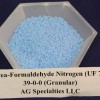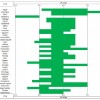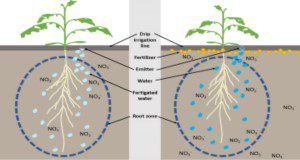The five Rs of nutrient stewardship is a mnemonic device used to emphasize accuracy and precision for nutrient management so as to apply the (1) right source of fertilizer at the (2) right rate at the (3) right time in the (4) right place with the (5) right irrigation. Because the majority of Florida’s soils are sandy, this fifth R is imperative for sustainable nutrient management for commercial crop production. These main points of nutrient management (source, rate, time, place, irrigation) may help enhance sustainability by reducing pollution by eutrophication, nitrogen loss through ammonia volatilization, and climate change from soil greenhouse gas emission. This new 8-page publication of the UF/IFAS Horticultural Sciences Department was written by Mary Dixon and Guodong Liu.
https://edis.ifas.ufl.edu/hs1386
Tag: Nutrition and Fertilizers for Vegetables
Description of Enhanced-Efficiency Fertilizers for Use in Vegetable Production
 In response to the Federal Clean Water Act of 1972 and the Florida Restoration Act of 1999, a series of best management practices (BMPs) was implemented to improve surface and ground water quality. BMPs are cultural practices that, when implemented as a plan, help reduce the environmental impact of production while maintaining yield and quality. One of these BMPs includes the use of controlled-release fertilizer, which is an enhanced-efficiency fertilizer. This publication describes the common enhanced-efficiency fertilizers and the factors affecting their use in Florida vegetable production. This 9-page fact sheet was written by Luther Carson and Monica Ozores-Hampton, and published by the UF Department of Horticultural Sciences, October 2014.
In response to the Federal Clean Water Act of 1972 and the Florida Restoration Act of 1999, a series of best management practices (BMPs) was implemented to improve surface and ground water quality. BMPs are cultural practices that, when implemented as a plan, help reduce the environmental impact of production while maintaining yield and quality. One of these BMPs includes the use of controlled-release fertilizer, which is an enhanced-efficiency fertilizer. This publication describes the common enhanced-efficiency fertilizers and the factors affecting their use in Florida vegetable production. This 9-page fact sheet was written by Luther Carson and Monica Ozores-Hampton, and published by the UF Department of Horticultural Sciences, October 2014.
http://edis.ifas.ufl.edu/hs1247
Nitrogen Cycling and Management for Romaine and Crisphead Lettuce Grown on Organic Soils
 Lettuce reaches harvest in 60–70 days in South Florida. This short growing season leads to high demands for nitrogen fertilization to maintain adequate plant-available N concentrations in the soil. Growers need to supply the required amounts of N to obtain high yields. Lettuce growers also need to know the nutritional status of the crop through soil and plant tissue testing. This 4-page fact sheet was written by Luis Santos, Alan L. Wright, Yigang Luo, Huangjun Lu, and D. Calvin Odero, and published by the UF Department of Soil and Water Science, September 2013.
Lettuce reaches harvest in 60–70 days in South Florida. This short growing season leads to high demands for nitrogen fertilization to maintain adequate plant-available N concentrations in the soil. Growers need to supply the required amounts of N to obtain high yields. Lettuce growers also need to know the nutritional status of the crop through soil and plant tissue testing. This 4-page fact sheet was written by Luis Santos, Alan L. Wright, Yigang Luo, Huangjun Lu, and D. Calvin Odero, and published by the UF Department of Soil and Water Science, September 2013.
http://edis.ifas.ufl.edu/ss588
Soil pH Range for Optimum Commercial Vegetable Production (HS1207)
 Soil pH affects nutrient bioavailability by controlling the chemical forms of nutrients. This 11-page fact sheet provides information about soil pH basics to commercial growers, county Extension agents, and college students specializing in vegetable production. Written by Guodong Liu and Edward Hanlon, and published by the UF Department of Horticultural Sciences, October 2012.
Soil pH affects nutrient bioavailability by controlling the chemical forms of nutrients. This 11-page fact sheet provides information about soil pH basics to commercial growers, county Extension agents, and college students specializing in vegetable production. Written by Guodong Liu and Edward Hanlon, and published by the UF Department of Horticultural Sciences, October 2012.
http://edis.ifas.ufl.edu/hs1207
How to Reduce Clogging Problems in Fertigation (HS1202)
 Fertigation is the process of applying fertilizers through an irrigation system by injecting them into the water. Because of its effectiveness and efficiency, fertigation is widely used in vegetable and fruit production. However, clogging of lines and emitters may become a problem. This 7-page fact sheet provides practical suggestions for better fertigation management so growers can reduce clogging problems. Written by Guodong Liu and Gene McAvoy, and published by the UF Department of Horticultural Sciences, June 2012.
Fertigation is the process of applying fertilizers through an irrigation system by injecting them into the water. Because of its effectiveness and efficiency, fertigation is widely used in vegetable and fruit production. However, clogging of lines and emitters may become a problem. This 7-page fact sheet provides practical suggestions for better fertigation management so growers can reduce clogging problems. Written by Guodong Liu and Gene McAvoy, and published by the UF Department of Horticultural Sciences, June 2012.
http://edis.ifas.ufl.edu/hs1202
How to Convert Liquid Fertilizer into Dry Fertilizer in Fertigation for Commercial Vegetable and Fruit Crop Production (HS1200/HS1200)
 In recent years, more and more liquid fertilizers have been used in vegetable and fruit production. Typically, UF/IFAS recommendations are expressed as pounds per acre or kilograms per hectare. Thus, conversion either from a dry fertilizer basis (the UF/IFAS recommendation) to a liquid fertilizer basis, or from a liquid fertilizer source to the UF/IFAS recommended nutrient rate is often required for correct application rate. This 5-page fact sheet helps growers understand the conversion method from liquid to dry fertilizer. Written by Guodong Liu, David Sui, and Gary K. England, and published by the UF Department of Horticultural Sciences, April 2012.
In recent years, more and more liquid fertilizers have been used in vegetable and fruit production. Typically, UF/IFAS recommendations are expressed as pounds per acre or kilograms per hectare. Thus, conversion either from a dry fertilizer basis (the UF/IFAS recommendation) to a liquid fertilizer basis, or from a liquid fertilizer source to the UF/IFAS recommended nutrient rate is often required for correct application rate. This 5-page fact sheet helps growers understand the conversion method from liquid to dry fertilizer. Written by Guodong Liu, David Sui, and Gary K. England, and published by the UF Department of Horticultural Sciences, April 2012.
http://edis.ifas.ufl.edu/hs1200
Are Phosphorous and Phosphoric Acids Equal Phosphorous Sources for Plant Growth? (HS1010/HS254)
 Phosphorus (P) is one of the 17 elements essential for plant growth and development, and is also a key component in some agrochemicals, such as phosphorous acid. Thus, there are two types of P closely associated with crop production. The similarity of terms such as phosphoric acid and phosphorous acid may create some confusion as to the actual content and efficacy of these products. This 7-page fact sheet explains what phosphorous acid is and examines both its fungicidal activity and nutrient value. Written by Asha M. Brunings, Guodong Liu, Eric H. Simonne, Shouan Zhang, Yuncong Li, and Lawrence E. Datnoff, and published by the UF Department of Horticultural Sciences, March 2012.
Phosphorus (P) is one of the 17 elements essential for plant growth and development, and is also a key component in some agrochemicals, such as phosphorous acid. Thus, there are two types of P closely associated with crop production. The similarity of terms such as phosphoric acid and phosphorous acid may create some confusion as to the actual content and efficacy of these products. This 7-page fact sheet explains what phosphorous acid is and examines both its fungicidal activity and nutrient value. Written by Asha M. Brunings, Guodong Liu, Eric H. Simonne, Shouan Zhang, Yuncong Li, and Lawrence E. Datnoff, and published by the UF Department of Horticultural Sciences, March 2012.
http://edis.ifas.ufl.edu/hs254
SL319/CV009 Commercial Vegetable Fertilization Principles
Revised! SL319, a 13-page illustrated fact sheet by G.J. Hochmuth and E.A. Hanlon, focuses on vegetable fertilization in various regions of Florida, and provides information about the principles and methods needed to construct a well-planned fertilization program that is consistent with BMPs. Includes references. Published by the UF Department of Soil and Water Sciences, March 2010.
http://edis.ifas.ufl.edu/cv009
SL293/SS506 Using Composted Poultry Manure (Litter) in Mulched Vegetable Production
SL-293, a 9-page illustrated fact sheet by George Hochmuth, Robert Hochmuth, and Rao Mylavarapu, answers vegetable producers’ questions about what poultry manure and litter are, what plant nutrients they contain, considerations for using them, results of research in Florida, how to use it in a mulched-bed system, and how to collect and submit for testing poultry manure samples. Includes references. Published by the UF Department of Soil and Water Science, October 2009.
http://edis.ifas.ufl.edu/SS506
SL303/SS516 Recommended Fertilizer Rates for Vegetables Grown in Raised-Bed, Mulched Cultural Systems
SL-303, a 6-page illustrated fact sheet by George Hochmuth and Edward Hanlon, explains the linear bed foot (LBF) concept and provides easy-to-use tables for converting a fertilizer recommendation from pounds per acre to pounds per 100 LBF. Published by the UF Department of Soil and Water Science, July 2009.
http://edis.ifas.ufl.edu/SS516
HS1156 Review of Nutrient Management Systems for Florida Vegetable Producers
HS1156, a 17-page white paper from the UF/IFAS Vegetable Fertilizer Task Force, identifies differences between actual fertilization practices and UF/IFAS fertilizer recommendations, especially for vegetables grown with subsurface (Central and South Florida) and overhead (Miami-Dade County) irrigation. The recommendations of the VFTF aim at bridging the gaps between science-based results and the diversity in production systems found in the Florida vegetable industry. Includes references. Published by the UF Department of Horticultural Sciences, April 2009.
http://edis.ifas.ufl.edu/HS1156
